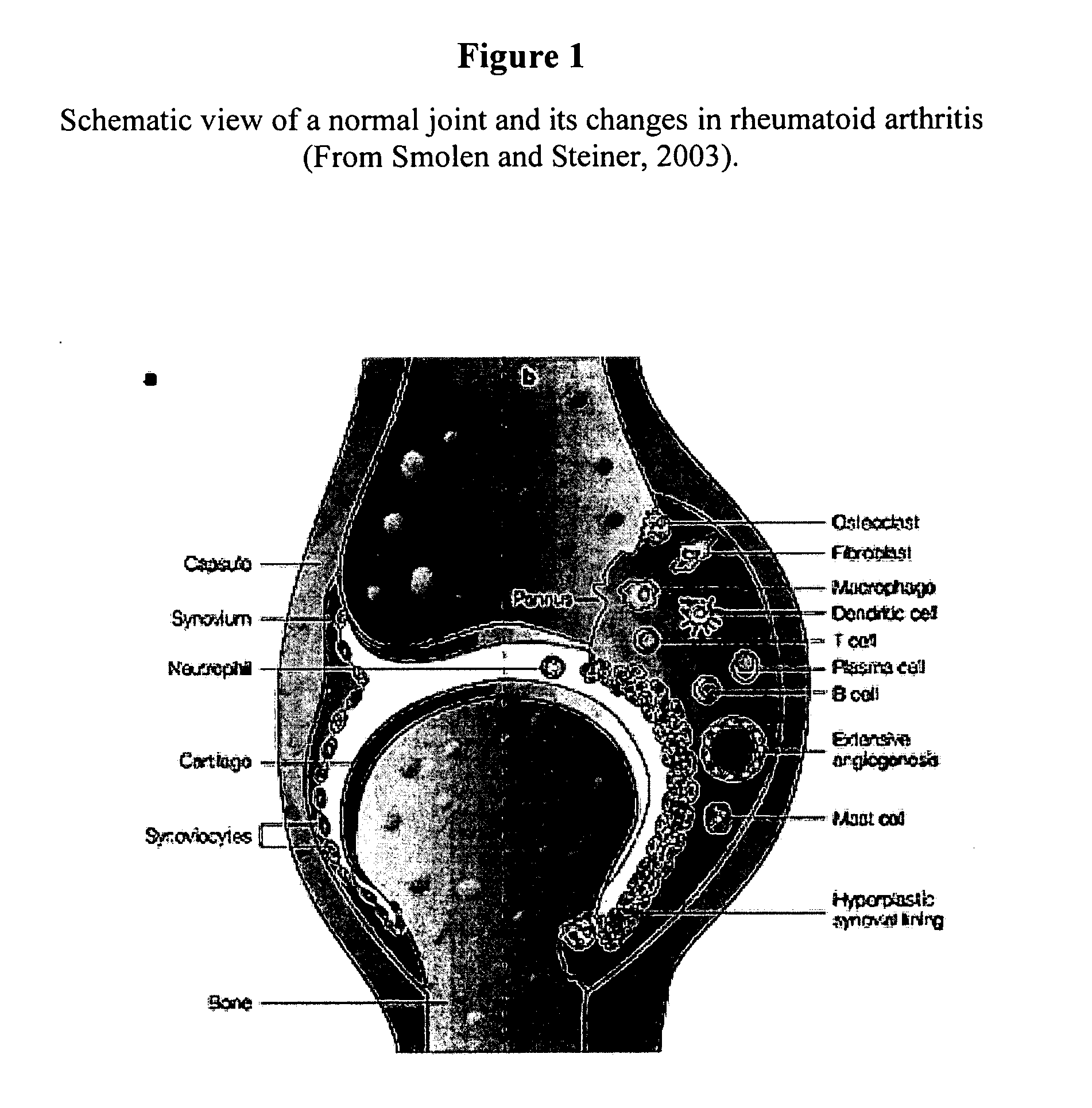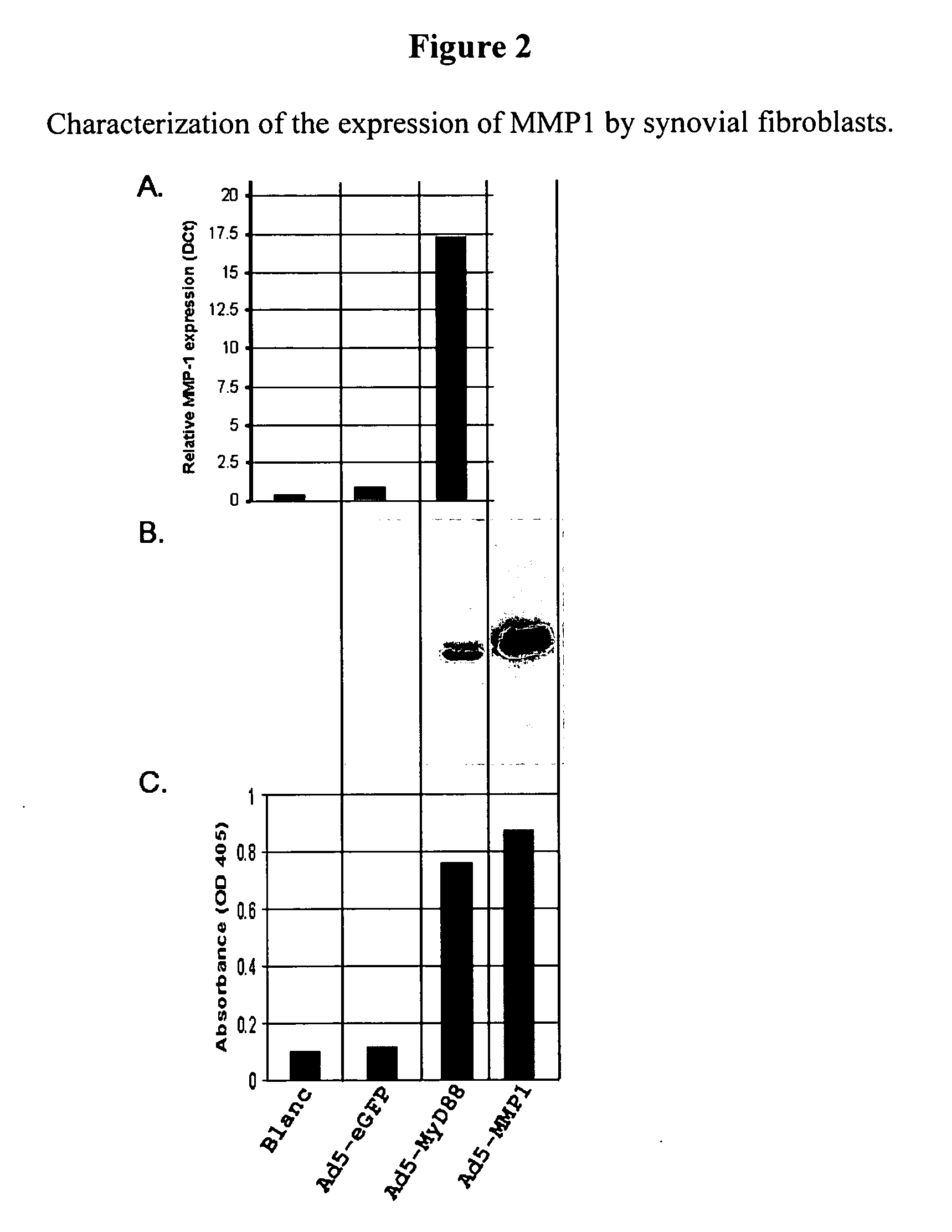Molecular targets and compounds, and methods to identify the same, useful in the treatment of joint degenerative and inflammatory diseases
a technology of molecular targets and compounds, applied in the field of identifying compounds and expression inhibitors, can solve the problems of lack of consensus regarding the precise mechanism of driving, substantial disability and pain, and loss of joint functionality
- Summary
- Abstract
- Description
- Claims
- Application Information
AI Technical Summary
Benefits of technology
Problems solved by technology
Method used
Image
Examples
example 1
Development of the Reverse MMP1 Assay
[0190] The MMP1 assay is developed by first testing the capacity of synovial fibroblasts (SFs) to produce MMP1.
[0191] To evaluate the capacity of SFs to produce MMP1, these cells were infected with a recombinant adenovirus mediating the expression of the MYD88 adaptor molecule involved in the pro-inflammatory IL1 signaling pathway. This virus is expected to increase MMP1 expression in these cells (see Vincenti and Brinckerhoff, 2002).
[0192] 40,000 SFs are seeded per well of a 6-well plate in DMEM+10% FBS and each well is either infected with a recombinant adenovirus mediating the expression of eGFP, MYD88 or MMP1 (with a multiplicity of infection (MOI) of 7500 viral particles per cell (vp / cell)) or left uninfected (blank). The SF expression of MMP1 is first determined at the mRNA level, by means of real-time, quantitative PCR. RNA of the cells infected with the control viruses is prepared 48 hours post infection using the SV RNA isolation kit ...
example 2
Screening of 11,744 “Ad-siRNAs” in a Reverse MMP1 Assay
[0202] An arrayed collection of 11,744 different recombinant adenoviruses mediating the expression of shRNAs in SFs are screened using the reverse MMP1 assay. These shRNAs cause a reduction in expression levels of genes that contain homologous sequences by a mechanism known as RNA interference (RNAi). The 11,744 Ad-siRNAs contained in the arrayed collection target 5046 different transcripts. On average, every transcript is targeted by two to three independent Ad-siRNAs. A schematic representation of the screening process is illustrated in FIG. 6. As discussed in more detail below, SFs are seeded in 384 well plates and infected the day thereafter with the arrayed shRNA library, whereby each well is infected with one individual Ad-siRNA. Five days after infection, the medium is refreshed and cells are triggered with the supernatant of TNFα treated THP-1 cells. Two days after addition of the trigger, supernatant...
example 3a
Testing of 339 Hits of the “Reverse MMP1 Assay” to Exclude Hits that Influence MMP1 Expression Levels in a Nonspecific Way
[0215] To eliminate general toxicity (reduced viability) of SFs by the Ad-siRNAs as the cause of reduced expression of MMP1 in the reverse MMP1 assay, the CellTiter-Glo Luminescent Cell Viability Assay (Promega) is used. This Assay determines the number of viable cells in culture based on the quantity of ATP present, which is proportional to the presence of metabolically active cells. In this assay, cells are grown in a white 96 well plate at a density of 3000 cells / well in 100 μl Synovial Cell growth medium (Cell Applications, Inc.). After overnight incubation, cells are infected with the confirmed hits from the reverse MMP1 assay. Five days after infection, the medium is removed and replaced by 50 μl M199 medium supplemented with 1% FBS. The plate and its content are equilibrated to room temperature for 30 minutes. 50 μl celltiter-Glo reagent is added to the w...
PUM
| Property | Measurement | Unit |
|---|---|---|
| molecular weight | aaaaa | aaaaa |
| time | aaaaa | aaaaa |
| total volume | aaaaa | aaaaa |
Abstract
Description
Claims
Application Information
 Login to View More
Login to View More - R&D
- Intellectual Property
- Life Sciences
- Materials
- Tech Scout
- Unparalleled Data Quality
- Higher Quality Content
- 60% Fewer Hallucinations
Browse by: Latest US Patents, China's latest patents, Technical Efficacy Thesaurus, Application Domain, Technology Topic, Popular Technical Reports.
© 2025 PatSnap. All rights reserved.Legal|Privacy policy|Modern Slavery Act Transparency Statement|Sitemap|About US| Contact US: help@patsnap.com



